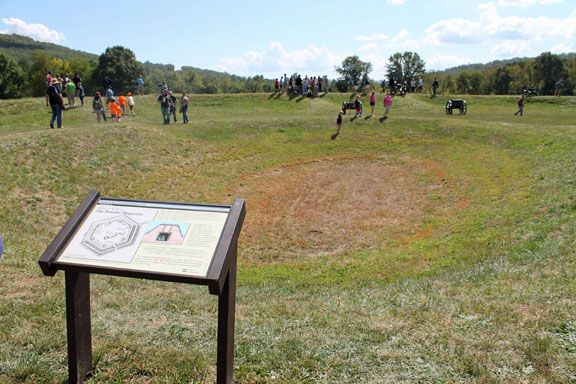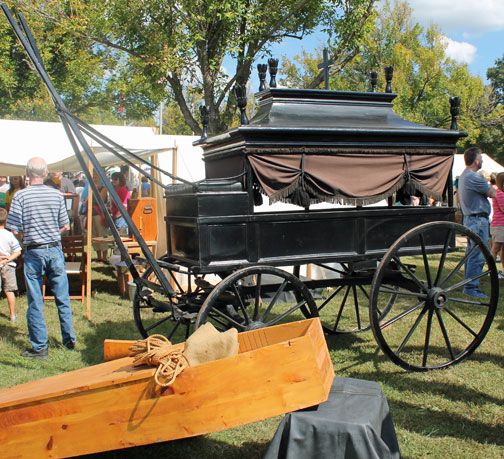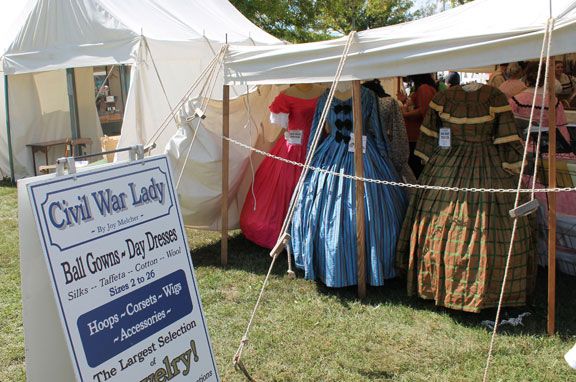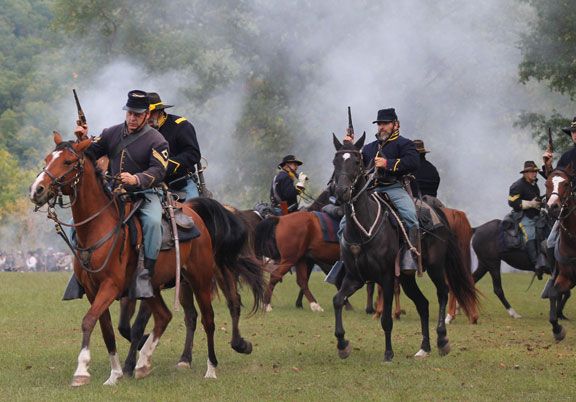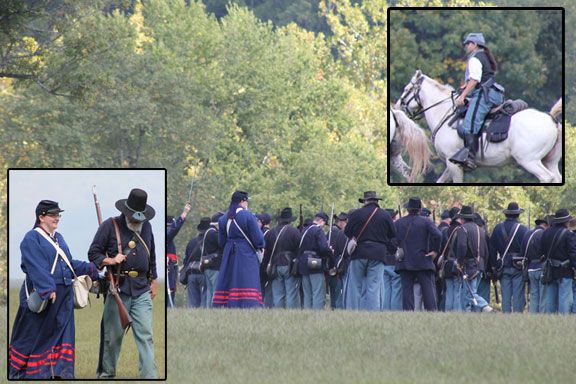 We’ve been studying the Civil War this semester and while I had several books selected on the subject for my son to read to himself we were given the opportunity to listen to someone else read aloud the G.A. Henty novel With Lee in Virginia. The narrator was Jim Hodges of Jim Hodges Productions who specializes in unabridged recordings of Henty titles. The physical CD we received had an MP3 format which works in computers and some stereos (like the one in our car). We were also given a PDF Study Guide for the same title. We listened to the first portion of the story while traveling to and from a Civil War reenactment of the 150th anniversary of the Battle of Pilot Knob. The whole story takes 11+ hours so a good portion had to be listened to at home.
We’ve been studying the Civil War this semester and while I had several books selected on the subject for my son to read to himself we were given the opportunity to listen to someone else read aloud the G.A. Henty novel With Lee in Virginia. The narrator was Jim Hodges of Jim Hodges Productions who specializes in unabridged recordings of Henty titles. The physical CD we received had an MP3 format which works in computers and some stereos (like the one in our car). We were also given a PDF Study Guide for the same title. We listened to the first portion of the story while traveling to and from a Civil War reenactment of the 150th anniversary of the Battle of Pilot Knob. The whole story takes 11+ hours so a good portion had to be listened to at home.
Each track corresponded to a chapter of the novel – the chapter title even appeared on the CD player. There were no subdivisions within the chapter so if you couldn’t listen to the 30+ minutes it took to listen to it entirely, you’d have to note the time where you stopped and fast forward to that spot on a subsequent listening. Mr. Hodges was an excellent narrator –reading neither too fast or too slow and enunciating quite well. I never had trouble understanding him (middle aged hearing). The only weak point was his reading of dialogue. At one point my son said Mr. Hodges reminded him of Data from Star Trek and looking back I can see his point. Mr. Henty wrote with very few contractions so everyone’s words seemed more formal. There were also times (like when the protagonist was confronting an evil overseer whipping a slave) that Mr. Hodges didn’t seem to emote as much as we might have liked. Part of that could be the written words themselves—we’re not likely to use the word “shan’t” especially when we’re upset, but as a narrator he didn’t have a choice in what to say.
On the whole, the story grew on us and as we became more concerned about the characters and their fate we focused less and less on whether Mr. Hodges had enough feeling in his narration. And let’s be clear this is an audiobook—no background music, no sound effects. We follow the main character through several famous Civil War battles: Manassas, Fredericksburg, Chancellorsville as well as his capture and escape. There are a fair number of chapters that deal with exploits away from the war too (helping a fugitive slave and retrieving that slave’s kidnapped wife).
Along with listening to the story, we had study guide vocabulary to define and questions for each chapter. The vocabulary was most helpful. It’s more noticeable when your reading a page and stumble across an unknown word than when you’re listening to narration. We worked on the words before listening and then tried to see if we could catch them being read.
The questions could cover anything from listening retention (e.g. How does Vincent bring Wildfire under submission?) to vocabulary (e.g. What does secede mean?) to history (e.g. What is the Merrimac, and what about it is very new to naval warfare?). While we did try to answer the questions (some requiring outside research), we did not do the activities which could be a creative writing assignment or watching an online video. I don’t know when the PDF file was created, but I found several linked web pages were no longer available.
In this review I’m trying to focus on the product, that is the audiobook, but I feel a word or two about Mr. Henty’s work itself is in order as some people might take offense. The “N” word is mentioned several times and a character in the first chapter states:
“I consider that the slave with a fairly kind master is to the full as happy as the ordinary English laborer. He certainly does not work so hard, if he is ill he is carefully attended to, he is well fed, he has no cares or anxieties whatever, and when old and past work he has no fear of the workhouse staring him in the face…Were I to liberate all the slaves on this estate to-morrow and to send them North, I do not think that they would be in any way benefited by the change. They would still have to work for their living as they do now, and being naturally indolent and shiftless would probably fare much worse.’’ [emphasis added]
I don’t know if these sentiments are coming from the character (who was a southern slaveholder, but originally from England) or Henty himself, but it certainly warranted a pause in listening to discuss whether the slaves themselves would have agreed with these statements. And maybe that’s the goal anyway – to be able to have meaningful discussions and learn from great literature of the past.
The MP3 CD retails for $25 and the Study Guide is available for $12. You can listen to a sample chapter on Mr. Hodges’ website before purchasing. The audiobooks are not recommended for children under 8. The study guide was created by a teacher who has worked with K-6 grade kids, and I would lean towards the upper end of that range before using it.



 I mentioned last week that God was putting a lot of opportunities to the more about the Bible itself in our path lately. We’re still studying who wrote it and how certain books were chosen for inclusion in both Sunday services and Schnickelfritz’s Bible merit. Now we’ve got a another review product by
I mentioned last week that God was putting a lot of opportunities to the more about the Bible itself in our path lately. We’re still studying who wrote it and how certain books were chosen for inclusion in both Sunday services and Schnickelfritz’s Bible merit. Now we’ve got a another review product by  Recently we were given the opportunity to review two treasure hunts from
Recently we were given the opportunity to review two treasure hunts from 
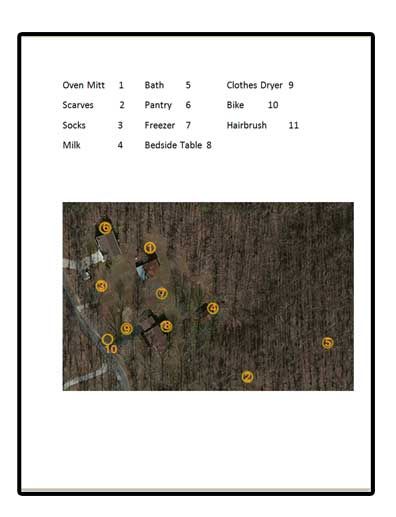

 I can’t believe we’re at the end and I can’t believe I managed to post every week, but here we are at letter Z. There was no doubt in my mind that I’d be sharing about the wonderful St. Louis Zoo. It’s ranked one of the top zoos in the nation and it’s FREE! That’s not to say there aren’t attractions within the zoo that you must pay for, like the train or the opportunity to pet stingrays (the stingrays and the Children’s zoo are free during the first hour of the day). There is a fee to park in the zoo’s lots, but you can park in Forest Park for free and walk in. (While you’re in the park, you can check out the Art Museum, the Science Center, and the Muny).
I can’t believe we’re at the end and I can’t believe I managed to post every week, but here we are at letter Z. There was no doubt in my mind that I’d be sharing about the wonderful St. Louis Zoo. It’s ranked one of the top zoos in the nation and it’s FREE! That’s not to say there aren’t attractions within the zoo that you must pay for, like the train or the opportunity to pet stingrays (the stingrays and the Children’s zoo are free during the first hour of the day). There is a fee to park in the zoo’s lots, but you can park in Forest Park for free and walk in. (While you’re in the park, you can check out the Art Museum, the Science Center, and the Muny).






 I’ll begin this post with a confession. I was planning to write about the Youzeum—a health/anatomy- themed, interactive museum in Columbia, Mo. But when I went to find hours and prices I found out that it had closed just two years after our chance to visit. I could write about the sign of the times--no wonder childhood obesity and diabetes are rampant…. someone finally comes up with an engaging and fun way to learn about their prevention and the place closes for lack of attendance. Instead, I’m thinking off the cuff and the only thing Y post I could come up with is Young Clydesdales.
I’ll begin this post with a confession. I was planning to write about the Youzeum—a health/anatomy- themed, interactive museum in Columbia, Mo. But when I went to find hours and prices I found out that it had closed just two years after our chance to visit. I could write about the sign of the times--no wonder childhood obesity and diabetes are rampant…. someone finally comes up with an engaging and fun way to learn about their prevention and the place closes for lack of attendance. Instead, I’m thinking off the cuff and the only thing Y post I could come up with is Young Clydesdales.
 Do you ever feel like God is hitting you over the head, trying to get your attention on a certain issue? I’ve been feeling that lately about studying the Bible. Not reading it, but studying the book itself—how it was written, how we can trust its authenticity, shy certain books were included and others not. Right now our church is doing a 6 week study on these issues, I’m going over the same material with my son for his Royal Rangers merit, and I’ve got to reviews for products dealing with the Bible. The first of those comes from
Do you ever feel like God is hitting you over the head, trying to get your attention on a certain issue? I’ve been feeling that lately about studying the Bible. Not reading it, but studying the book itself—how it was written, how we can trust its authenticity, shy certain books were included and others not. Right now our church is doing a 6 week study on these issues, I’m going over the same material with my son for his Royal Rangers merit, and I’ve got to reviews for products dealing with the Bible. The first of those comes from 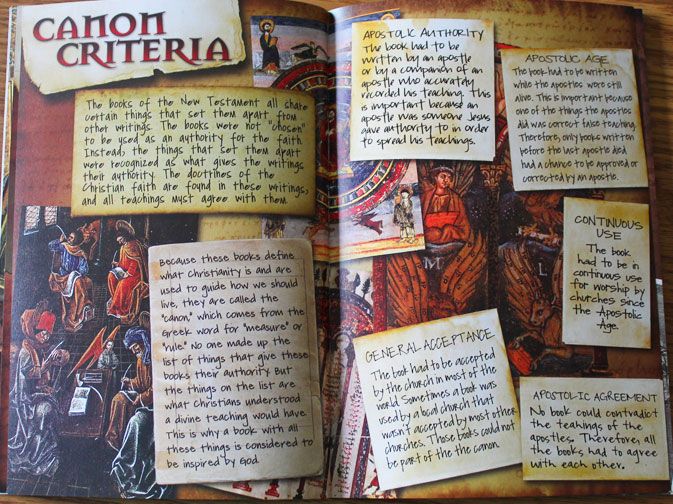
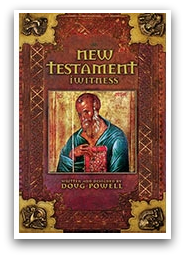 Last week in church the pastor asks if anyone knew what the term “canon” meant. Although he never actually called on someone in the congregation to answer, I could thanks to this book. It not only explained that “canon” comes from the Greek word for measuring stick, but what characteristics each book needed to measure up to in order to be considered part of the canon. The first section of the book gives example after example of early church fathers’ lists of accepted books—all which were written before the Councils of Hippo and Carthage (the generally accepted sources of the New Testament list of books).
Last week in church the pastor asks if anyone knew what the term “canon” meant. Although he never actually called on someone in the congregation to answer, I could thanks to this book. It not only explained that “canon” comes from the Greek word for measuring stick, but what characteristics each book needed to measure up to in order to be considered part of the canon. The first section of the book gives example after example of early church fathers’ lists of accepted books—all which were written before the Councils of Hippo and Carthage (the generally accepted sources of the New Testament list of books).  This book also deals Canon, manuscripts, and copying but not to the extent of the New Testament book. Did you know that originally there were only 22 books, not 39? It’s not that more books were added, but the original books were divided. For example, what was originally known as “The Five Scrolls” became Ruth, Esther, Ecclesiastes, Song of Solomon, and Lamentations when the Septuagint translated the original Hebrew into Greek.
This book also deals Canon, manuscripts, and copying but not to the extent of the New Testament book. Did you know that originally there were only 22 books, not 39? It’s not that more books were added, but the original books were divided. For example, what was originally known as “The Five Scrolls” became Ruth, Esther, Ecclesiastes, Song of Solomon, and Lamentations when the Septuagint translated the original Hebrew into Greek.






